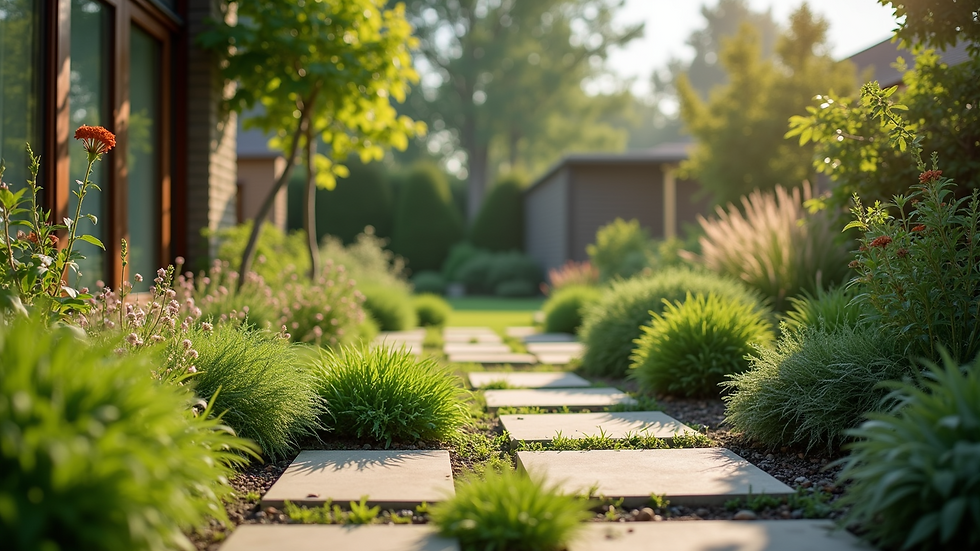Are Eco-Friendly Practices Becoming a Must-Have in Luxury Property Design?
- Louis Estherby

- Mar 7
- 4 min read
Updated: Jun 26
When environmental concerns are at the forefront of buyers' attention, the luxury design landscape is shifting dramatically. Luxury is no longer just about opulence—it's about sustainability. Buyers are seeking homes that embody their values of elegance and eco-friendliness. For these individuals, sustainability isn't a compromise; it's a genuine opportunity to create beautiful spaces with lasting benefits for both themselves and the planet.
This article explores the key facets of sustainable luxury design, showcasing how eco-friendly practices can elevate property value and provide unforgettable experiences for discerning buyers.
Timeless Appeal with Reclaimed and Natural Materials
One captivating trend in sustainable luxury design is the use of reclaimed and natural materials. Imagine a stunning home featuring reclaimed wood or antique bricks, which tell a story and evoke a sense of history. These materials reduce the demand for new resources and align perfectly with today's eco-conscious mindset.
Take, for example, a luxury property showcasing reclaimed oak beams or a living room adorned with vintage bricks from a local salvage yard. Such features not only add rustic charm and sophistication but also resonate with the authenticity that high-net-worth buyers crave.
Research shows that homes incorporating unique natural elements tend to command higher prices—on average, properties with reclaimed materials can see a valuation boost of up to 15%. This growing interest in sustainable materials reveals a fantastic opportunity for developers to capture the attention of eco-aware buyers.

Energy Efficiency: Luxury Without Waste
Luxury and energy efficiency no longer stand in opposition. Today, high-end buyers actively seek homes with state-of-the-art energy-efficient systems that minimise their carbon footprint.
Consider properties equipped with solar panels or smart home technologies that monitor and optimise energy usage. For instance, homes with automated systems can adjust heating and lighting based on occupancy, leading to energy savings of up to 30% annually.
Investing in energy-efficient technology not only showcases a commitment to sustainable living but also significantly boosts a property's value. Homes that embrace these upgrades are more attractive and promote comfortable living.
Water Conservation: Blending Luxury with Responsibility
With climate change reshaping global weather patterns, water conservation has now become a cornerstone of sustainable design. Luxury homes equipped with cutting-edge water-saving systems not only commit to eco-responsibility but can also lower maintenance costs for homeowners.
Features such as rainwater harvesting systems and low-flow faucets can enhance the home’s aesthetic while providing practical benefits. For example, a property that incorporates grey water recycling systems can save approximately 40% on water usage, a significant relief for homeowners.
Increasingly, potential buyers are drawn to properties that showcase innovative water-saving technologies. By prioritising these systems, developers can create desirable, sustainable homes that stand apart in the luxury market.

The Emotional Connection: Aligning Values and Design
Luxury transcends materials and technology; it’s about fostering an emotional connection. Today's affluent buyers want homes that reflect their values and showcase a commitment to sustainability.
Think about how creating spaces that echo environmental consciousness can enhance the luxury experience. When buyers find their ideals represented in their homes—through thoughtful design and eco-friendly initiatives—they feel a meaningful connection. This deep resonance can lead to quicker sales and higher property values.
By blending elegant design with sustainable practices, developers can tap into this demographic and create unique selling points that resonate with environmentally conscious buyers.
Future-Proofing Through Sustainability
As consumer needs evolve, luxury real estate must also adapt. Homes that prioritise sustainability are positioned well for the future, aligning with changing market trends.
Properties that integrate eco-friendly designs not only appeal to current buyers but also attract future generations. For instance, homeowners can save approximately 20-30% on utility bills through sustainable practices, highlighting the financial benefits of energy-efficient investments.
Focusing on sustainability ensures that properties retain their value in an ever-changing market, making it a crucial strategy for future-proofing luxury homes.
Creating Unique Selling Points with Eco-Luxury
In a competitive market, developers can set themselves apart by integrating sustainable design elements that add tangible value. Eco-luxury features can serve as unique selling points that captivate discerning buyers and help them visualise their dream home.
Whether it’s utilising recycled materials, installing renewable energy systems, or designing outdoor spaces that connect with nature, sustainability can elevate a property. With eco-friendly living increasing in popularity, homes that embrace these features can achieve premium pricing, attracting a dedicated clientele.

Embracing a Sustainable Future
Sustainable luxury design marks a pivotal change in how we perceive luxury living. As affluent buyers increasingly value environmental responsibility, property developers have a remarkable opportunity to craft homes that embody these ideals while enhancing property value.
By incorporating reclaimed materials, promoting energy efficiency, and creating emotional connections through thoughtful design, developers can successfully tap into the growing demand for eco-friendly residential spaces. As sustainability takes centre stage, luxury design evolves to align elegance with environmental stewardship, paving the way for a brighter, more sustainable future in high-end real estate.

Comments